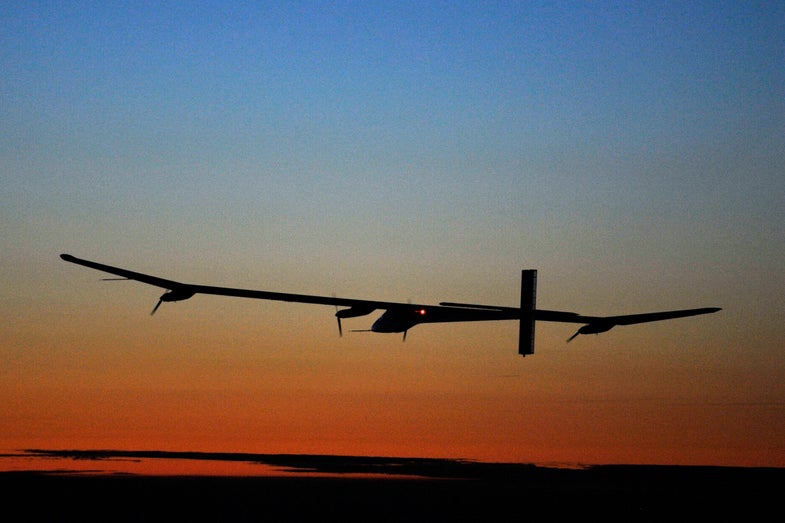A team of visionary Swiss engineers and at least one test pilot with nerves of steel have pushed solar-powered flight to the next level, completing an overnight flight that proves solar flight is possible even when the plane’s fuel source dips behind the horizon. This morning test-pilot André Borschberg successfully put Solar Impulse HB-SIA on the ground safely after 26 hours and nine minutes of flight powered solely by the sun.
Click to launch the photo gallery
The flight began yesterday morning, as Borshberg slowly climbed to a maximum altitude just beyond 28,000 feet while more than 10,000 solar cells stretched across its massive 200-foot wingspan soaked up solar energy and stored it in batteries inside the plane. Solar Impulse then slowly descended as the day’s sunlight waned, acting as a glider to use the least amount of power possible. The plane switched the power back on at somewhere around 5,000 feet and cruised easily through the rest of the night on the stored solar energy.
No such flight had ever been attempted before, and its success is quite a milestone for solar-powered flight, proving that a day’s worth of solar flight can generate enough excess power to get a plane through the night. Looking purely at the numbers, it seems that if a plane can make it to the next morning, it could potentially fly for extended periods without landing barring mechanical problems.
With that in mind, the Solar Impulse crew is celebrating today then getting right back to work. Next up for the world’s most advanced solar-powered plane: a transatlantic flight followed by an around-the-world sojourn that will be carried out by the team’s second prototype solar plane, which they will begin building this summer.
Solar Impulse
Entering the Night
After seven years of testing, tweaking, and pushing the technological envelope, Solar Impulse HB-SIA finally hit its most critical milestone to date, completing a 26-hour flight that saw the solar-powered plane fly through the night. The carbon-fiber aircraft’s 200-foot wingspan is covered in 10,748 solar cells that – aside from powering the plane – store excess power in batteries that enable the plane to operate even after sunset. The all-night flight is an important proof of concept for Solar Impulse, proving solar flight is viable even when the sun doesn’t shine.
Ready for Takeoff
After seven years of testing, tweaking, and pushing the technological envelope, Solar Impulse HB-SIA finally hit its most critical milestone to date, completing a 26-hour flight that saw the solar-powered plane fly through the night. The carbon-fiber aircraft’s 200-foot wingspan is covered in 10,748 solar cells that – aside from powering the plane – store excess power in batteries that enable the plane to operate even after sunset. The all-night flight is an important proof of concept for Solar Impulse, proving solar flight is viable even when the sun doesn’t shine.
Pilot André Borschberg
After seven years of testing, tweaking, and pushing the technological envelope, Solar Impulse HB-SIA finally hit its most critical milestone to date, completing a 26-hour flight that saw the solar-powered plane fly through the night. The carbon-fiber aircraft’s 200-foot wingspan is covered in 10,748 solar cells that – aside from powering the plane – store excess power in batteries that enable the plane to operate even after sunset. The all-night flight is an important proof of concept for Solar Impulse, proving solar flight is viable even when the sun doesn’t shine.
Preparing for Night Flight
After seven years of testing, tweaking, and pushing the technological envelope, Solar Impulse HB-SIA finally hit its most critical milestone to date, completing a 26-hour flight that saw the solar-powered plane fly through the night. The carbon-fiber aircraft’s 200-foot wingspan is covered in 10,748 solar cells that – aside from powering the plane – store excess power in batteries that enable the plane to operate even after sunset. The all-night flight is an important proof of concept for Solar Impulse, proving solar flight is viable even when the sun doesn’t shine.
Pink Skies at Night
After seven years of testing, tweaking, and pushing the technological envelope, Solar Impulse HB-SIA finally hit its most critical milestone to date, completing a 26-hour flight that saw the solar-powered plane fly through the night. The carbon-fiber aircraft’s 200-foot wingspan is covered in 10,748 solar cells that – aside from powering the plane – store excess power in batteries that enable the plane to operate even after sunset. The all-night flight is an important proof of concept for Solar Impulse, proving solar flight is viable even when the sun doesn’t shine.
First Night Flight
After seven years of testing, tweaking, and pushing the technological envelope, Solar Impulse HB-SIA finally hit its most critical milestone to date, completing a 26-hour flight that saw the solar-powered plane fly through the night. The carbon-fiber aircraft’s 200-foot wingspan is covered in 10,748 solar cells that – aside from powering the plane – store excess power in batteries that enable the plane to operate even after sunset. The all-night flight is an important proof of concept for Solar Impulse, proving solar flight is viable even when the sun doesn’t shine.






